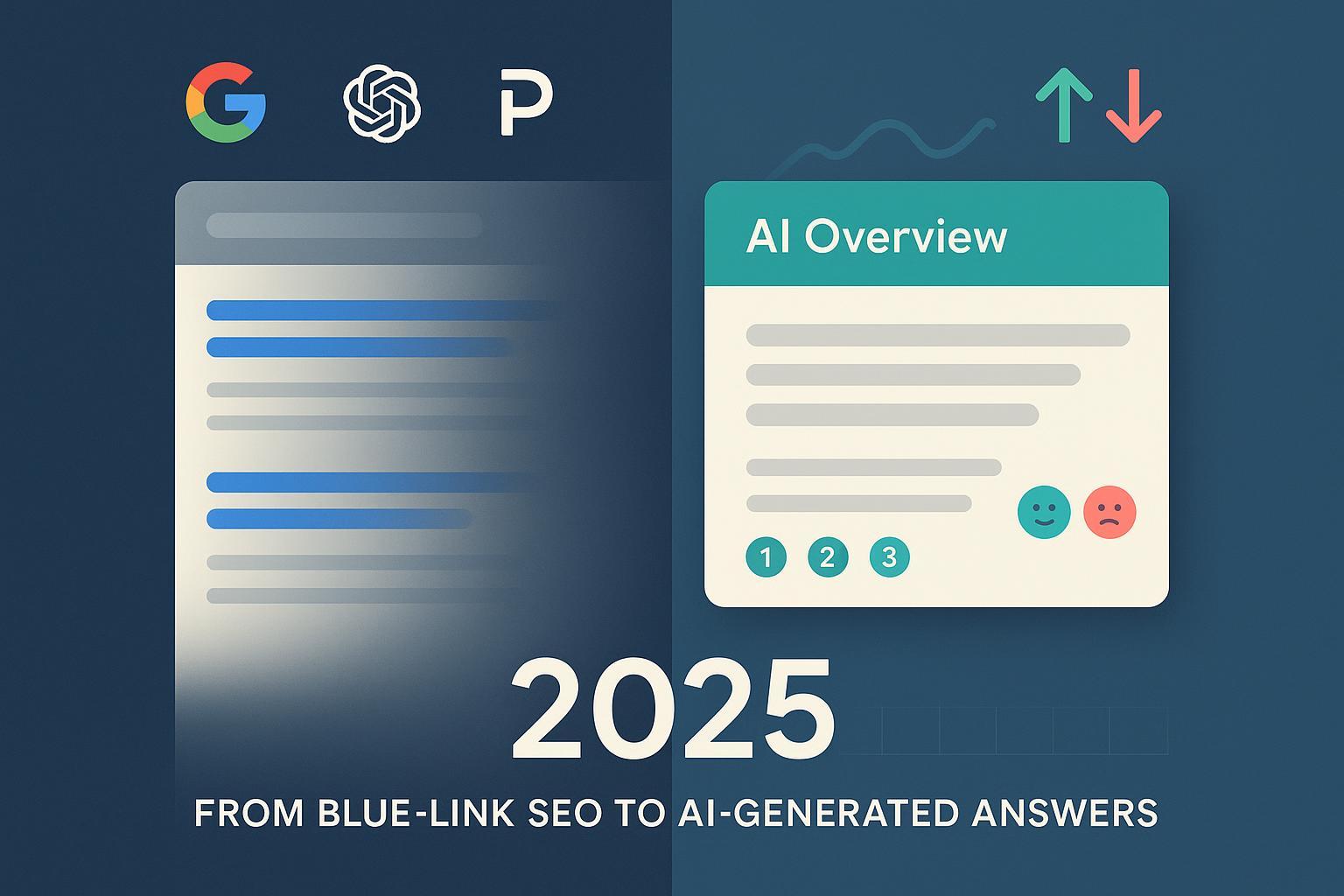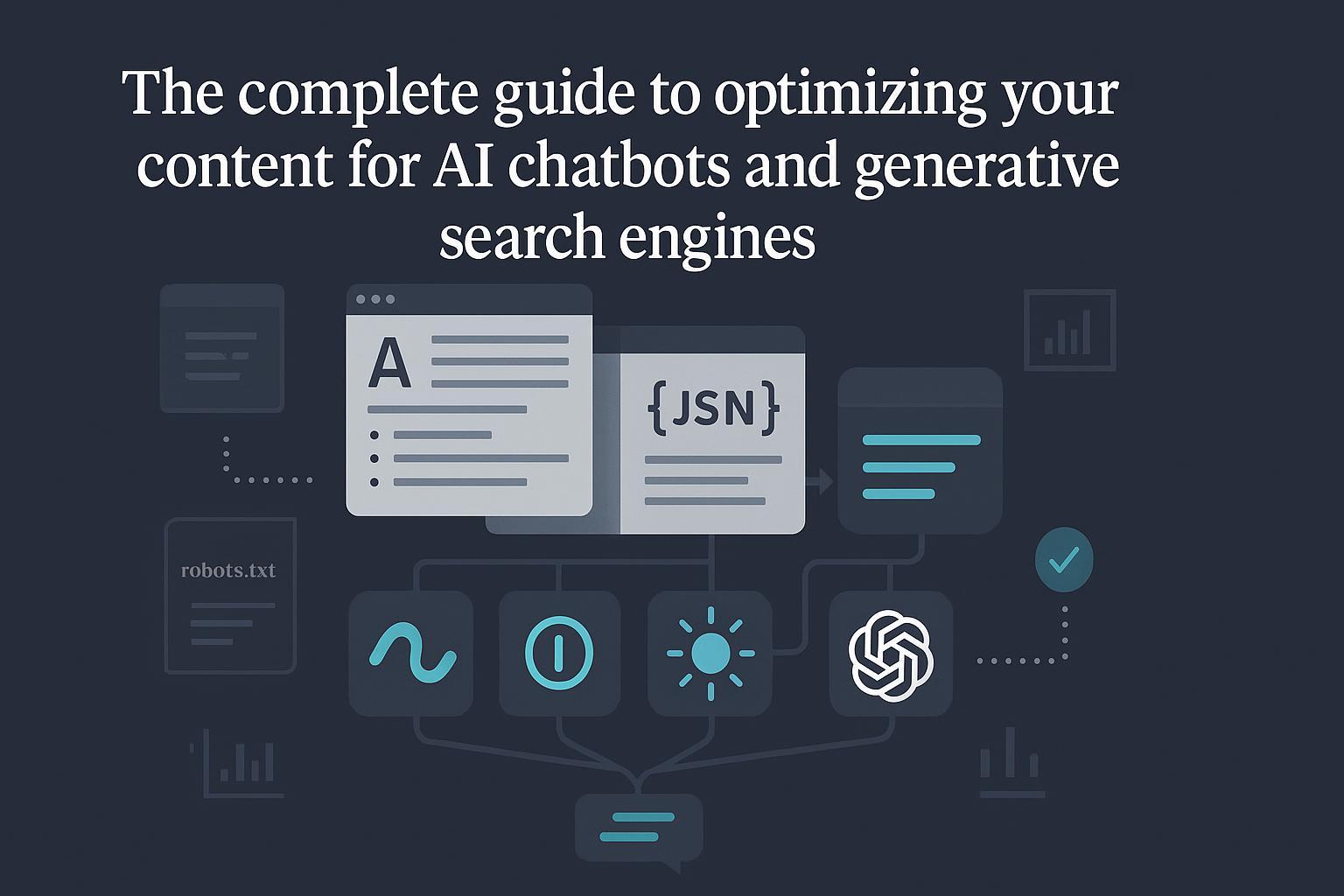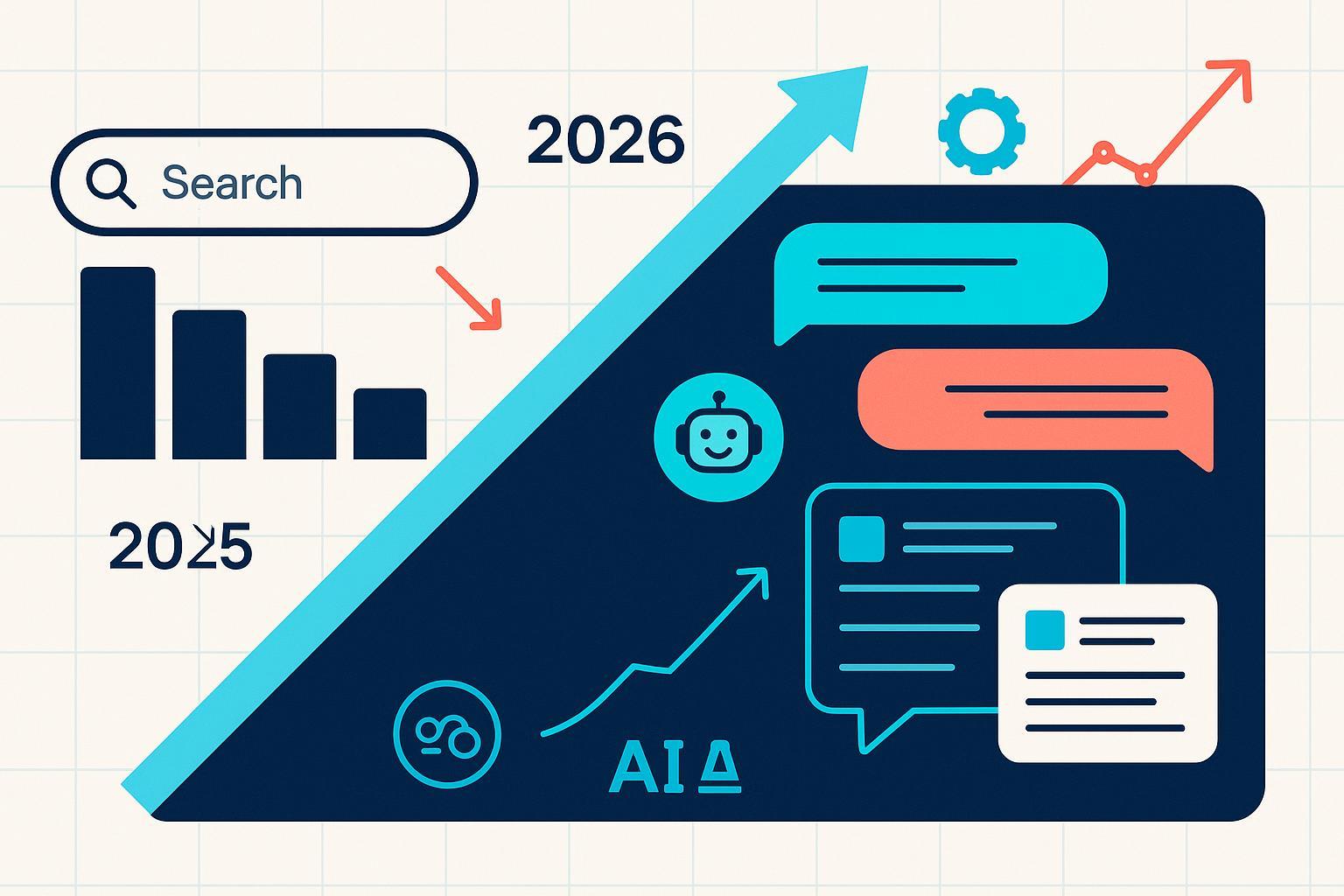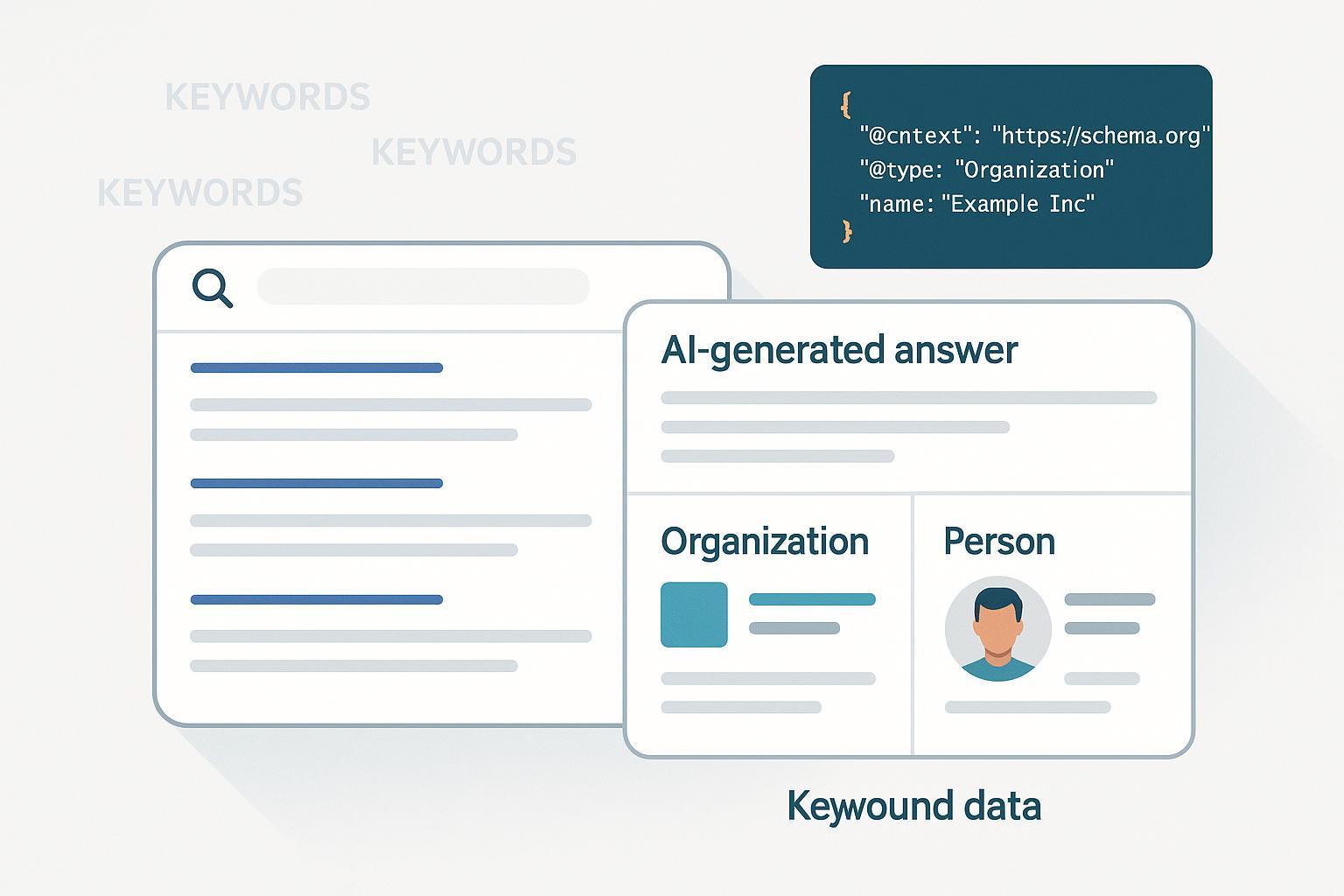Why Traditional SEO Is Dying: Generative Engine Optimization in 2025
Discover how Google's AI Overviews and generative search are cutting traffic. Learn 2025 strategies for GEO success and actionable KPIs now.


In 2025, many marketers are asking a painful question: Why are organic sessions falling even when rankings look stable? One clear driver is the rise of AI summaries on result pages. In a July 2025 study of U.S. users, the Pew Research Center reported that “Google users who encounter an AI summary are less likely to click on links to other websites than users who do not see one,” with AI summaries showing in about 18% of searches in the study window and links within those summaries being clicked about 1% of the time. See the details in the Pew Research Center short read on AI summaries and link clicks.
Why the classic click-through model is breaking
Publishers have felt the impact in their referral dashboards. In August 2025, premium members of Digital Content Next reported a median 10% year-over-year decline in Google Search referrals over an eight-week period from late May to late June, with declines outpacing gains two-to-one and some categories seeing far steeper drops. See the methodology and breakdown in Digital Content Next’s analysis of Google’s AI push and publisher traffic. The industry press summarized similar patterns, noting declines as much as 25%; see eMarketer’s August 2025 briefing on AI Overviews and referral traffic.
To be fair, Google presents a different lens: overall usage. In May 2025, the company said that in major markets, “AI Overviews is driving over 10% increase in usage of Google for the types of queries that show AI Overviews.” You can read the claim in the Google Search blog update on AI Mode and AI Overviews. Both can be true: more searching overall, but fewer outbound clicks when an AI answer satisfies intent. That is precisely why a 2025 strategy has to go beyond blue-link rankings.
Meanwhile, AI answers are appearing often enough to matter. Multiple independent 2025 scans converge on a mid‑teens share of queries triggering AI Overviews, especially for informational and long‑tail intents. For example, Semrush’s July 2025 research found coverage in the low-to-mid teens and documented how AI-mode layouts alter click dynamics; see Semrush’s 2025 AI Overviews Study. Visual dominance compounds the effect: WordStream’s August 2025 compilation estimates that AI Overviews plus Featured Snippets can occupy roughly 75.7% of mobile screen real estate and 67.1% on desktop; see WordStream’s 2025 stats on AI Overviews screen share.
What replaces “rank and click”: Generative Engine Optimization (GEO)
Traditional SEO isn’t dead—its click-through model is being de‑emphasized on queries where AI answers satisfy intent. The competitive advantage shifts to becoming a cited, trusted source inside AI answers across multiple engines: Google AI Overviews/AI Mode, ChatGPT’s browsing answers, and Perplexity’s aggregated responses. That operating system is often called Generative Engine Optimization (GEO). If you need a primer, see this definition: What is Generative Engine Optimization (GEO)?
What GEO requires in 2025:
- Entity authority and integrity
- Ensure your organization and key authors are recognized, consistent, and reconciled across Knowledge Graph and Wikidata; maintain consistent naming, NAP, and identifiers.
- Source packaging and transparency
- Publish original, expert content with clear authorship, dated updates, methods boxes, and links to primary sources. AI systems strongly prefer non‑commodity evidence.
- Structured data and extraction-friendly formatting
- Mark up pages with Article/Organization/Person/FAQPage/HowTo where appropriate; use crisp answer blocks, lists, tables, and question-shaped headings for easy extraction.
- First‑party data and POV
- Distill unique insights, benchmarks, and case evidence—material that LLMs can cite rather than paraphrase from generic sources.
Google’s own 2025 guidance emphasizes original, people-first content, robust schema, and clear authorship. See Google Developers’ “AI features and your website” documentation for official recommendations.
Engine-specific playbooks you can deploy this quarter
-
Google AI Overviews/AI Mode
- Align content to intent clusters where AI Overviews frequently appear (informational, long‑tail). Ship concise, verifiable answers with supporting citations.
- Strengthen E‑E‑A‑T signals via expert bylines, org credibility pages, and transparent sourcing.
- Maintain topical hubs so AI can summarize across your corpus; add FAQ sections targeting follow‑ups.
- Validate schema and load speed; ensure mobile-first UX.
- Deep dive here: Best Practices for Google’s AI Mode (2025)
-
ChatGPT browsing answers
- Publish explainers with unique data points, step-by-steps, and tables to increase the odds of citation when browsing is invoked.
- Use descriptive headings and anchor fragments; maintain a clean, ad‑light UX that’s easy to parse.
- Keep a current “evidence and methods” note at the bottom of high‑value pages to bolster trust.
-
Perplexity
- Target concise Q&A‑style content with clear conclusions and named sources; keep metadata precise (titles, OG tags, last‑updated dates).
- Improve entity disambiguation so Perplexity’s aggregation assigns the right brand and authors.
A practical monitoring workflow (mid‑article example)
For most teams, a repeatable GEO workflow includes three loops: inclusion, quality, and outcomes.
- Inclusion: Track whether your content is cited across engines for your priority queries; compare against competitors; log changes weekly.
- Quality: Review the sentiment and accuracy of AI answers that mention your brand; flag harmful hallucinations and prioritize fixes or counter-evidence.
- Outcomes: Correlate changes in AI citation share with branded demand lift, direct visits, and assisted conversions to attribute value beyond sessions.
Teams often use a cross‑engine monitor to consolidate citations, sentiment, and history. For instance, Geneo supports multi‑engine AI visibility monitoring, citation tracking, sentiment analysis, and historical comparisons that can slot into this workflow. Disclosure: Geneo is our product.
Measurement and KPIs for 2025 (beyond sessions)
Executive teams need metrics that reflect reality in a zero‑click world. Here are durable KPIs you can put into your 2025 scorecards:
-
AI citation rate
- Definition: Percentage of tracked priority queries where your brand/content is cited in the AI answer on each engine.
- Why it matters: It’s the generative-era analog to “ranking.”
-
Citation share of voice (SOV)
- Definition: Share of citations attributed to your brand among a defined competitor set across engines and intents.
- Why it matters: Reflects competitive authority inside AI answers.
-
Sentiment distribution in AI answers
- Definition: Ratio of positive/neutral/negative sentiment when your brand appears in generative results.
- Why it matters: AI narratives shape perception; sentiment skews influence conversion.
-
Assisted conversions influenced by AI answers
- Definition: Triangulate branded search lift, direct traffic lift, and assisted conversions (multi‑touch) during periods when AI citation share moves.
- Why it matters: Captures value that classic last‑click models miss.
-
SERP presence mix
- Definition: The proportional mix of classic blue links, SERP features, and AI answer inclusion for your tracked queries.
- Why it matters: Helps allocate effort to the formats that still drive discovery.
-
Entity health
- Definition: Completeness and consistency of Organization/Person schema, Knowledge Graph presence, and Wikidata alignment.
- Why it matters: Underpins credible inclusion in AI answers.
If you’re formalizing these metrics, see the internal explainer on the AI Search Visibility Score and adapt it to your own reporting stack.
The 90‑day plan to future‑proof your organic strategy
Weeks 1–2: Baseline and risk map
- Audit where AI answers appear for your top 200–500 informational queries; note if your brand is cited and the competing sources.
- Score entity health (org and top 5 authors). Close obvious gaps in Organization, Person, Article schema, and author bios.
- Pull referral deltas for informational pages since March 2025 to quantify exposure to AI‑answer displacement.
Weeks 3–6: Content packaging and authority
- Ship extraction‑friendly updates: add crisp answer blocks, tables, and FAQs to top pages; standardize “evidence and methods” boxes; improve internal linking to topical hubs.
- Publish 2–3 first‑party data pieces (benchmarks, surveys, or original analyses) with transparent methods. These raise your odds of being cited.
- Reconcile entities with Knowledge Graph/Wikidata; fix naming conflicts and add identifiers.
Weeks 7–10: Engine‑specific plays and monitoring
- Execute Google AI Mode plays on 5–10 high‑impact topics; track inclusion weekly and iterate.
- Optimize 10+ explainers for ChatGPT browsing (structured headings, unique data, clean UX).
- Produce Q&A‑forward pages for Perplexity on 10–20 long‑tail topics.
- Stand up your monitoring loop (inclusion → quality → outcomes) and define alert thresholds for losses and gains.
Weeks 11–13: Measurement and governance
- Add AI citation rate, citation SOV, and sentiment to your executive dashboard; link changes to branded demand lift and assisted conversions.
- Update your editorial and SEO checklists to include GEO steps (schema validation, evidence packaging, entity checks) before publish.
- Present an executive readout with Q1 2026 projections and budget re‑allocation proposals.
Executive implications you can take to the board
- The marginal ROI of classic blue‑link rankings compresses wherever AI answers satisfy intent. Budgets should shift from “rank acquisition” to “answer inclusion” and evidence creation.
- GEO is not a tool—it’s an operating model spanning content, data, and measurement. Treat it like a capability build, not a one‑off project.
- Entity and author credibility are now performance levers. Invest in subject‑matter authors, source transparency, and first‑party research.
- Measurement must evolve. Sessions and CTR are insufficient; add inclusion, sentiment, and assisted outcomes.
Evidence and methods note
This article references multiple 2025 primary sources and official documentation. Behavioral and referral data reflect specific windows (March–August 2025) and may vary by category and intent. AI Overviews coverage and UX prominence differ by device and locale. For official product guidance, see Google Developers’ AI features overview. For prevalence and screen-share context, see Semrush’s 2025 AI Overviews Study and WordStream’s 2025 AI Overviews statistics. ChatGPT usage scale referenced in 2025 press and app analytics; a representative overview is in TechCrunch’s August 2025 report on ChatGPT weekly active users. Publisher referral changes summarized from DCN’s August 2025 member analysis and eMarketer’s briefing. Links are provided once each for readability.
Updated on 2025‑10‑09
- Added 2025 citations from Pew, DCN/eMarketer, Semrush, WordStream, TechCrunch, and Google’s 2025 guidance.
- Aligned checklists to Google’s September 2025 UX refinements for AI Mode.
Next steps: If you’re formalizing a GEO program this quarter, consider piloting the monitoring workflow above and, if helpful, using a cross‑engine tracker like Geneo to consolidate inclusion, sentiment, and history. Then bring those AI‑era KPIs into your executive dashboard for 2026 planning.




